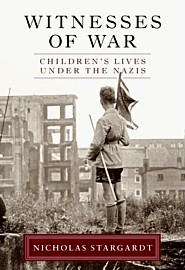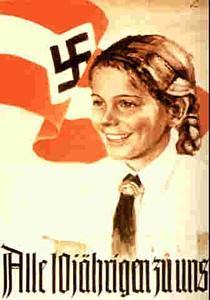Essay (back
to top)
In his chilling and gut wrenching book, Witnesses of War: Children’s Lives Under the Nazis, Nicholas Stargardt provides readers with various personal accounts of children who grew up under the power of the Third Reich. Not limited in his research, Stargardt touches on the history of children across Europe, ranging from Jewish children in the ghettos, to those who served in the Hitler Youth. Although the book presents anecdotes from various children of all ages, Stargardt specifically chooses to introduce fourteen children ranging in age from three to seventeen, to show the diverse situations that children were exposed to and experienced first hand. Drawing on a variety of sources ranging from diaries to drawings, Stargardt proves to readers that while some similarities existed, the impact of the war on children followed no universal pattern.
Stargardt’s monograph encompasses an overall history of the war starting with the events of pre-war Europe through liberation in 1945, while simultaneously incorporating children’s narratives. Beginning his first chapter in Poland, Stargardt introduces readers to the paradoxical nature of the entire war. Janina, a ten year old living in Poland in 1939, observed the German attack with curiosity, not fear (Stargardt, 23). In contrast, twelve year old Wanda Przybylska experienced the war from the other side—inside the Warsaw ghetto where she was ultimately killed in the uprising (Stargardt, 135). This type of story repeats itself throughout the book; some children suffered simply for being born into certain families.
Saturated with information, the book introduces readers to the relentless efforts of the Nazis to cleanse Europe not only of Jews, but of all others who Hitler considered detrimental to the regime as well. German officials played on the emotions of parents and encouraged them to send their disobedient or “wayward” children to disciplinary homes in order to, “‘save’ the young from their families and themselves” (Stargardt, 58). Of these reformatories, the most draconian, Breitenau, subjected those who were housed there to conditions that seemed hauntingly similar to the concentration camps (Stargardt, 60). Children were forced to undergo testing to see whether or not they could be integrated into society, and more often than not it was race, not test scores, that determined their fate in the end. Furthermore, it was the job of the asylum doctors and workers to save society, not the children (Stargardt, 73).
Experiencing levels of atrocities even worse than those in the reformatories were those children who were sent to asylums and later murdered. During the first six months of the war approximately 3,000 asylum patients were murdered by being gassed or shot, and by 1941 the number reached well over 10,000 (Stargardt, 83). Those who were spared could be sent to Himmler’s “labor education camps,” which appeared to be virtually synonymous with youth concentration camps (Stargardt, 90). Stargardt uses letters sent from parents to their children in the asylums to show the complete lack of knowledge these parents possessed. In one instance, a mother wrote her son Peter begging him to respond to her letter, unaware to the fact that he had already died (Stargardt, 91). Those who did manage to survive these medical killings often suffered from starvation, and most faced hardships through later years as a result of their treatment in the asylums.
German children such as Liselotte Günzel and Klaus Seidel, who not only supported the Nazis, but also actively participated in the war efforts, experienced the war from a completely different viewpoint. Using her diary as a primary source, Stargardt shows how Günzel, the daughter of a Berlin Social Democrat, completely idolized the Nazis and their political ideas. Negating the comments of many Germans who claimed they were unaware of Jewish treatment, Günzel clearly acknowledges the concentration camps in her diary entry from August 31, 1943. She states, “Mummy told me recently about how the Jews have been killed in camps ... it is good that they’re gone from Germany, but actually to murder them!” (Stargardt, 154). Also in 1943, sixteen year old Seidel worked in Hamburg on anti-aircraft batteries (Stargardt, 229). Using Seidel as an example, Stargardt depicts just how far the Nazis would go to win the war, and just how hard the German citizens, children included, were willing to fight. It also shows a further paradox, for these children who were previously being sent away to be protected were now fighting and losing their lives for Germany.
Overall, Witnesses of War: Children’s Lives under the Nazis seeks to tell the stories of those children who had been previously overshadowed by the much larger aspects of the post-war world. As the son of a German-Jewish father, Nicholas Stargardt strives to shed light on the situations of those children whose lives were forever shaped by the impact of the Third Reich. Stargardt uses school assignments, artwork, diaries, and interviews with adults to attempt to piece together the stories of these children. While ultimately the book fails to offer a unifying conclusion encompassing all of the children, it proves the capabilities of Hitler and the Nazis to impact all children directly and indirectly through education, political policy, and racist ideals.
One of the key elements of the Nazi regime, as stressed by Stargardt, was its desire to keep the Aryan children safe from the war. At a time when racial purity existed as one of the most important national issues, Nazis strove to preserve the Aryan children who would be the next generation. In March 1939 it became mandatory for all children ages fourteen to eighteen to join the Hitler Youth, and by April 1940, the Jungvolk and Jungmädelbund were established for those children ten to thirteen (Stargardt, 34). Being part of the Hitler Youth was seen as an especially important thing for these children, and often forced Non-Aryans to recognize the extent of their separation. Thomas Geve, a Jewish boy from Berlin, even wore a Hitler Youth uniform in order to escape from the reality he faced as a German Jew (Stargardt, 44). To further protect Aryan children, some parents sent their children to live with distant relatives. In 1940, Party secretary Martin Bormann issued an order to send children on extended stays to the countryside, and in the first two months 189,543 children were evacuated (Stargardt, 52).
The trains carrying Hitler Youth children greatly contrasted with the trains that sent other children to the ghettos and eventually the concentration camps. Living in the Lodz ghetto, Dawid Sierakowiak experienced the harsh conditions of the Jews first hand, as he witnessed sickness, starvation, and death. Dawid’s diary reiterates these conditions in its repeated mention of constant hunger. In 1941 in Belaya Tserkov, approximately ninety Jewish children, the eldest being seven years old, were lined up and shot by German soldiers (Stargardt, 145). While the Germans aimed to protect the Aryan children, Stargardt shows the complete lack of humanity and basic human rights provided to those children not lucky enough to be born Aryan.
While it is easy to lump the children into “Jewish” and “German” subgroups, it would not be accurate; the book shows that many children existed in-between. Stargardt shows the path that was laid out for those who were neither Jewish nor German, a path that led to the “Germinization” of many young children. Taken from their homes without the consent of their parents, they were subjected to a plethora of tests to determine if they were suitable for being converted to German or not (Stargardt, 163). Those found acceptable for this transformation received new German identities, and often could be adopted by German families (Stargardt, 163). Some of the children were taken at such a young age that their native tongue, culture, and even family was completely wiped out of their memory. In the post war years, only 844 children were reunited with their non-German families, whereas 21,611 children had been taken during the war (Stargardt, 355). This displacement of children displays the complete chaos that occurred during and after the war when families were ripped apart and some never recovered.
One of the similarities that Stargardt finds between the children was the nature of their childhood games. Children such as three year old Uwe Timm wanted to play games to, “shoot the Russians dead and pile them all up” (Stargardt, 157). A picture in the book depicts two children playing ghetto policeman, an image which was not unfamiliar. Stargardt describes these horrific games as the children’s desire to make games out of the things which they feared the most (Stargardt, 173). Jewish children such as Ettie from the Lodz ghetto treated dolls as if they were real people, and assigned them rations and jobs, paralleling the child’s real life experiences (Stargardt, 175). These examples prove that the violence of the war crossed all boundaries, reaching children of every race, religion, and nationality.
The loss of parents after the war, and the way that loss shaped family life was another commonality among the children that Stargardt touches upon. This aspect of the war was felt throughout Europe; race alone could not save everybody. Thousands of households lost fathers to the front lines, the ghettos, or other forms of violence, and often children had to take on leadership roles in the already struggling households. Mothers, who feared rape and other atrocities, began to use their children as intermediaries in the bartering system with the Russians (Stargardt, 329). Some female children even became accustomed to “offering themselves” to guards rather than having to risk their food being taken away (Stargardt, 331). A total collapse of the innocence of children was rampant in the postwar years. Of German children alone, 1,250,000 became fatherless due to the war (Stargardt, 338). This undoubtedly had a negative effect on their upbringing. Even those whose fathers did come home struggled with how to resume a “normal” life after years of abnormality.
Still, Stargardt asserts that these shared experiences at the end of the war cannot bring about the conclusion that all children suffered in the same way. To say that would be similar to saying all Jewish and German citizens suffered the same—it simply is not true. While one reviewer criticizes Stargardt for failing to provide “a formal analysis that can bring out deeper significance” (Welch 2005), I believe that his book provides enough information for each reader to learn something previously undocumented. An overall analysis would only reiterate what Stargardt initially states: there is no distinct pattern to explaining the experiences of the children. Just as some Jews were sent to labor camps and some were sent straight to the gas chambers, children growing up in Europe lived in different realities.
Overall, Witnesses of War: Children’s Lives under the Nazis succeeds in providing readers with a new perspective to the Third Reich, the Holocaust, and World War II as European children saw it. Stargardt’s strength lies in his ability to combine complex world history with personal stories as seen through the eyes of the youth. The use of maps, drawings, and pictures draws the readers in even further and makes the stories of the kids come to life. Combining documents from the deceased with testimonies of the survivors, Stargardt supplies readers with unique testimony about a highly discussed and debated topic. Underlying the entire book is Stargardt’s notion that “whether children had any idea of what was going on depended to a large extent on what their parents knew and told them” (Stargardt, 154). Through the examples of children of different ages and nationalities, this standpoint is repeated over and over. As a historian and author, Nicholas Stargardt succeeds in shedding new light on old topics, and introducing the complex and understudied history of the children who grew up under the shadow of the Nazis.
|

